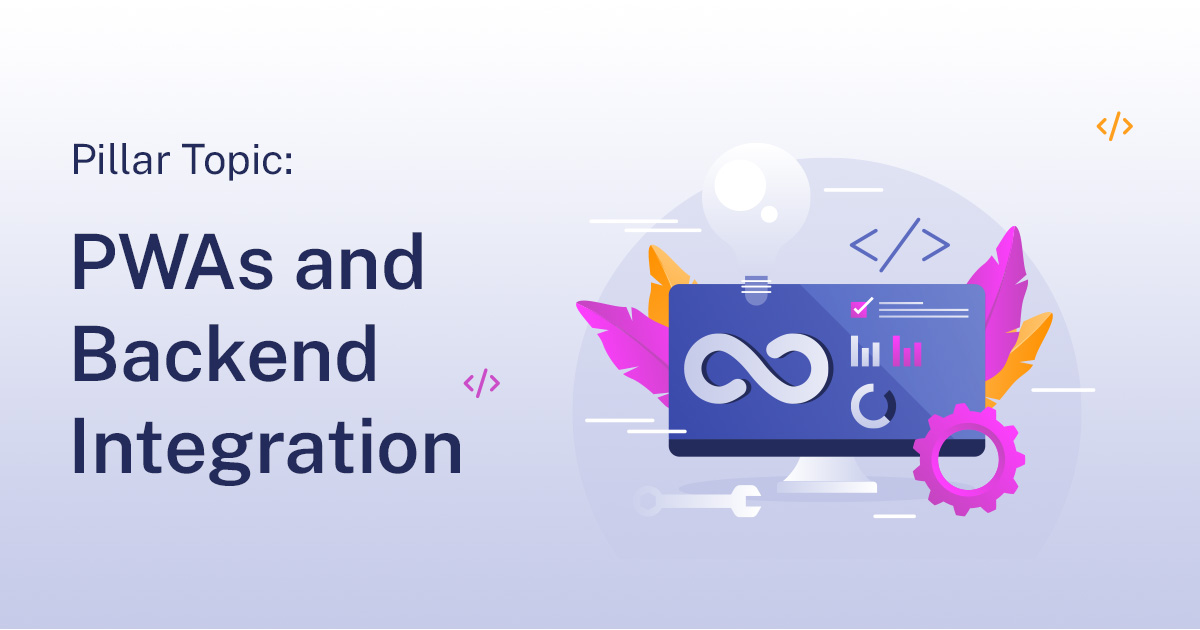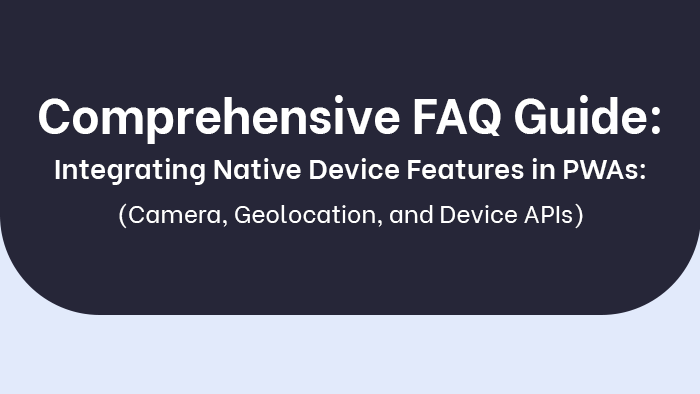
According to recent studies, the use of Progressive Web Apps (PWAs) has witnessed a significant surge in popularity. This trend has prompted the exploration of various backend integration frameworks such as Node.js, Django, and Ruby on Rails.
In this article, we delve into the realm of PWAs and backend integration by examining crucial aspects such as authentication and authorization mechanisms, real-time communication techniques, data synchronization strategies, and the correlation between PWAs and microservices.
By analyzing these elements objectively and impersonally, we aim to provide valuable insights for developers seeking to enhance their understanding and implementation of PWAs with robust backend frameworks.
Key Takeaways
- js, Django, and Ruby on Rails are popular backend integration frameworks for building PWAs.
- Cross-platform compatibility can be achieved through responsive design techniques.
- Performance optimization techniques like code minification and caching can improve speed and responsiveness.
- Security measures such as authentication protocols and encryption of sensitive data are crucial.
Building Progressive Web Apps with Backend Frameworks: Node.js, Django, or Ruby on Rails
One approach to building Progressive Web Apps (PWAs) with backend frameworks involves utilizing Node.js, Django, or Ruby on Rails. These frameworks offer a range of features and capabilities that can greatly enhance the development process and improve the overall performance of PWAs.
Cross platform compatibility is one of the key considerations when building PWAs with backend integration. To ensure seamless functionality across different devices and operating systems, developers should adhere to best practices such as using responsive design techniques, adapting layouts and UI elements to different screen sizes, and testing thoroughly on various platforms.
Performance optimization is another crucial aspect when integrating PWAs with backend frameworks. Techniques such as code minification, caching data at the client-side, lazy loading of resources, and reducing network requests can significantly improve speed and responsiveness. Additionally, optimizing server-side rendering and leveraging browser caching mechanisms can also contribute to better performance.
Security considerations are of utmost importance when it comes to PWAs with backend integration. Developers need to implement measures such as secure authentication protocols, encryption of sensitive data during transmission and storage, input validation for preventing SQL injection attacks or cross-site scripting vulnerabilities. Regular security audits should also be conducted to identify potential risks or weaknesses in the system.
Database integration plays a vital role in managing data storage and retrieval within PWAs. Efficient strategies for connecting PWAs to databases include establishing appropriate database structures, using indexed queries for faster data access, implementing effective caching mechanisms for frequently accessed data, and employing database management tools like object-relational mappers (ORMs).
API integration enhances PWA functionality by allowing third-party services or applications to be seamlessly incorporated into the app’s ecosystem. This enables additional features such as geolocation services, payment gateways or social media integrations. Developers should carefully select reliable APIs that align with their app’s requirements while ensuring proper authentication mechanisms are implemented for secure communication between the PWA and external APIs.
Authentication and Authorization in PWAs: Implementing User Management and Access Control
Authentication and authorization play a crucial role in PWAs, as they involve implementing user management and access control mechanisms. User authentication ensures that only authorized individuals can access the application and its resources. This process typically involves validating the user’s identity using credentials such as username and password. To enhance security, password encryption techniques are commonly employed to store user passwords securely.
Role-based access control (RBAC) is another important aspect of authentication and authorization in PWAs. RBAC allows administrators to define roles for different types of users and assign specific privileges to each role. This approach simplifies access control by grouping users based on their responsibilities or job functions.
Token-based authentication is an alternative method used in PWAs for user authentication. Instead of sending sensitive credentials with every request, tokens are generated upon successful login and sent back to the client. These tokens are then included in subsequent requests to validate the user’s identity without exposing their credentials.
Multi-factor authentication (MFA) adds an extra layer of security by requiring users to provide multiple forms of identification before accessing the PWA. This typically involves combining something the user knows (e.g., a password), something they have (e.g., a physical token or mobile device), or something they are (e.g., biometrics).
Real-time Communication in PWAs: WebSockets, Server-Sent Events, and WebRTC
Real-time communication in PWAs involves the implementation of technologies such as WebSockets, Server-Sent Events, and WebRTC to enable seamless and synchronized data exchange between the client and server. These technologies play a crucial role in enhancing user experience by providing real-time chat functionality, push notifications, integrating real-time data updates, collaborative editing, and even real-time gaming capabilities within Progressive Web Applications (PWAs).
Some key benefits of incorporating real-time communication in PWAs are:
- Real time chat functionality: By leveraging WebSockets or Server-Sent Events, PWAs can offer users the ability to engage in instant messaging or group chats without any noticeable delays. This enhances user engagement and facilitates effective communication.
- Push notifications in PWAs: With the help of service workers and push notification APIs, PWAs can deliver timely updates and alerts to users even when they are not actively using the application. This enables businesses to keep their users informed about important events or updates.
Integrating real-time data updates: Using technologies like WebSockets, PWAs can fetch and display live data from servers without requiring manual refreshes. This allows for a dynamic user experience where changes made on one device are instantly reflected on all connected devices.
Collaborative editing in PWAs: Real-time collaboration is made possible through technologies like Operational Transformation or Conflict-Free Replicated Data Types (CRDTs). These allow multiple users to work simultaneously on shared documents or projects with immediate synchronization of changes.
Real time gaming in PWAs: The low latency offered by WebRTC makes it suitable for implementing multiplayer games within PWAs. Users can engage in interactive gameplay experiences with other players around the world without having to install separate game applications.
Data Synchronization in PWAs: Offline-First Strategies and Conflict Resolution
Data synchronization in PWAs is a crucial aspect that involves the implementation of offline-first strategies and conflict resolution techniques to ensure seamless data exchange between the client-side and server-side components.
Offline-first strategies are designed to enable PWAs to work even when there is no internet connection available. By caching data on the client-side, PWAs can continue to function and provide a smooth user experience. These strategies involve storing data locally using technologies like IndexedDB or local storage, allowing users to access information even when offline.
Conflict resolution is an important consideration in data synchronization. In scenarios where multiple users are accessing and modifying the same set of data simultaneously, conflicts may arise when attempting to merge these changes. Conflict resolution techniques aim to resolve these conflicts in a way that maintains data integrity and ensures consistency across all devices.
To achieve effective data synchronization, backend integration plays a vital role. The server-side component needs to handle requests from PWAs, update databases accordingly, and notify clients about changes made by other users. This requires implementing appropriate APIs for communication between the client-side and server-side components.
PWAs offer several advantages for achieving seamless data synchronization. They can leverage service workers for background syncing capabilities, ensuring that updates are automatically applied once an internet connection becomes available again. Additionally, push notifications can be utilized to inform users about new updates or changes made by others.
PWAs and Microservices: Design Patterns and Scalability Considerations
Microservices architecture in PWAs allows for the development of scalable and modular systems by decoupling different components into independently deployable services. This architectural approach brings several benefits to PWAs, including increased flexibility, better fault tolerance, and improved scalability. However, it also introduces certain challenges that need to be addressed effectively.
To provide a comprehensive understanding of the current subtopic, let us explore the following aspects:
- Scalability challenges: As PWAs grow in popularity and usage, handling increased traffic becomes a critical concern. Microservices architecture enables horizontal scaling by distributing load across multiple instances of individual services. This approach facilitates efficient resource utilization and helps maintain consistent performance even during peak usage periods.
- Load balancing: To ensure optimal distribution of incoming requests, load balancing techniques can be employed. These techniques distribute requests evenly among multiple instances or replicas of microservices.
- Caching strategies: Implementing caching mechanisms at various levels can significantly enhance system performance by reducing the response time for frequently accessed data. Caching can be implemented at both client-side and server-side to improve overall efficiency.
- Fault tolerance: Microservices architecture provides inherent fault isolation as failures in one service do not propagate to others. By implementing appropriate error handling mechanisms and utilizing containerization technologies like Docker or Kubernetes, developers can enhance system reliability and minimize downtime.
Conclusion
In conclusion, building Progressive Web Apps (PWAs) with backend frameworks such as Node.js, Django, or Ruby on Rails provides a seamless user experience and efficient data management.
Implementing authentication and authorization ensures secure user management and access control.
Real-time communication through technologies like WebSockets, Server-Sent Events, and WebRTC enhances the interactivity of PWAs.
Data synchronization strategies like offline-first approaches and conflict resolution enable smooth operation even without an internet connection.
Finally, integrating PWAs with microservices allows for scalability and improved design patterns.
As the saying goes, ‘A well-built PWA is like a symphony orchestra – harmoniously combining different instruments to create a captivating performance.’

